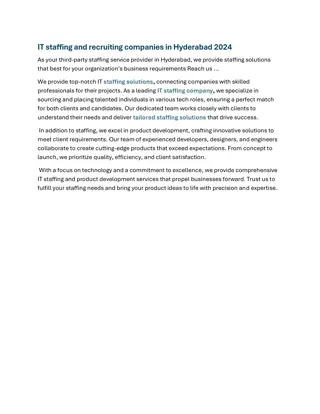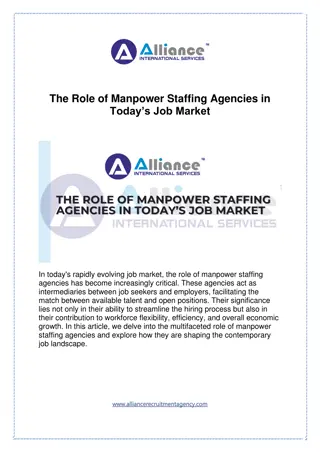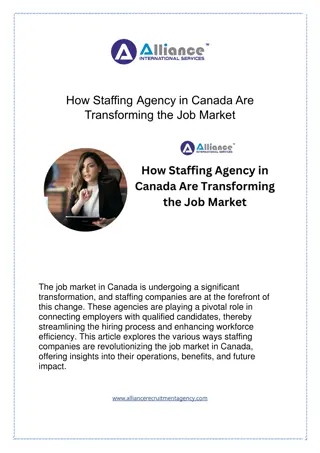Analysis of Public Health Agency of Canada Staffing Trends for FY 2018-2019
Investigating staffing patterns at the Public Health Agency of Canada for the fiscal year 2018-2019 reveals an increase in casual workers, stable indeterminate staff levels, and lower temporary assignments. The Agency's reliance on student hiring, promotions among indeterminate employees, and concerns over pay issues due to Phoenix data migration are highlighted. Mobility trends and growth or decline in temporary assignments are also examined.
Download Presentation

Please find below an Image/Link to download the presentation.
The content on the website is provided AS IS for your information and personal use only. It may not be sold, licensed, or shared on other websites without obtaining consent from the author.If you encounter any issues during the download, it is possible that the publisher has removed the file from their server.
You are allowed to download the files provided on this website for personal or commercial use, subject to the condition that they are used lawfully. All files are the property of their respective owners.
The content on the website is provided AS IS for your information and personal use only. It may not be sold, licensed, or shared on other websites without obtaining consent from the author.
E N D
Presentation Transcript
Public Health Agency of Canada (PHAC) Staffing-Related Statistics for Fiscal Year 2018-2019 National Staffing Union Management Consultation Committee (NSUMCC)
Purpose The following analysis was developed to: Investigate PHAC s utilization of students and casual workers Investigate PHAC s indeterminate population and external recruitment outcomes over the last 3 years Identify mobility trends of employee movements within the agency Examine growth / decline in volumes and rates of temporary assignments 2
Executive Summary Casual Workers The average population of casual workers grew by 18% in 2018/19 and their average population share increased from 4.5% of the workforce in 2017/18 to 5.1% in 2018/19. The rate of casual hiring rate increased by 2.2% points. Students Student hiring represents 40% of all external recruitment at the Agency since 2016/17. The majority (69%) of student hiring occurs in HSIB and IDPC. Stable indeterminate population The average indeterminate population remained flat in 2018/19. The rate of promotions for indeterminate employees rose to 7.1% in 2018/19, up from 3.1% in 2014/15. Lower volumes of actings & assignments Total actings and assignments in 2018/19 were down 18% from levels seen in 2016/17. Potential pay issues triggered by the Phoenix data migration may have discouraged employees from accepting acting tenures in fear of the uncertainties surrounding their regular pay. It is difficult to assess the extent to which Phoenix had affected employee behaviour towards acting opportunities as there is currently no data available on this subject. 3
Casuals Workers Overview PHAC - Average Population (By Tenure & FY) FY 2016/2017 FY 2017/2018 FY 2018/2019 Casual/AWR 117 Indeterminate 2054 Term 110 Student 123 Total 2404 107 2022 118 117 2364 126 2042 156 131 2455 In 2018/19, the average population of casuals rose by 18%, from 107 to 126 FTEs. From this increase, the relative share of casual employees grew from 4.5% to 5.1% of the PHAC workforce. The largest share belong to the EC occupational group. They account for one-third of all casual workers. 4 Substantive Population only
Casuals Workers Increased Hiring Activities The increasing casual population is reflected in PHAC s hiring practice in 2018/19 as the rate of casual hires jumped to 13.8% after hovering around 11.5% in the previous two fiscal years. In 2018/19 the Agency hired 64 more casual workers than in the previous year, a 23% increase. 5 Substantive Population only
Casuals Workers 2018/19 Hires Top 5 Occupational Groups Increased casual hires was most obvious in the CR category as casual hiring activities doubled. Casual hiring activities for the AS, PM and EC occupational groups also increased over the last fiscal year by 23%, 31% and 21% respectively. The EC group has typically accounted for 40% of annual casual hiring activities during the past 3 years. 6 Substantive Population only
Students Hires Despite accounting for approximately 5% of the population, student hiring represents 40% of all external recruitment for the Agency since 2016/17. IDPC and HSIB collectively accounted for 69% of all student hiring between 2016/17 to 2018/19. In 2018/19, the volume of student hires grew by 14.4% and drove up the hire rate up to 14.9% for the year. 7 Substantive Population only
Indeterminate Population Overview Nearly half (45%) of Indeterminate employees work within IDPC. Of all unionized indeterminate employees in 2018/19: 46% are under PSAC 38% are under CAPE 15% are under PIPSC 1% are under ACFO 8 Substantive Population only
Indeterminate Intake The EC occupational group accounts for 44% of all indeterminate intake over the last three fiscal years. The PA group collectively accounts for 39% of all indeterminate intake over the last three fiscal years. In 2018/19, approximately 1 in 8 indeterminate employees were new to the Agency. *Note of caution in interpretation of results: It has been speculated that a lag in the data entry of transfers out by the Pay Centre is contributing to the lower intake/departure rate observed across the department for 2018-2019. 9
Internal Movement Promotions and Transfers Internal movements within the Agency have been steadily climbing the bulk of which implies more career growth opportunities for employees. There were 126% more promotions issued in 2018/19 than there were in 2014/15, jumping from 64 to 145 within the five year span. Lateral movements presents opportunities for employees to develop skills horizontally in other roles. While the lateral movement rate has fluctuated between 3.7% and 4.6% since 2015/16 it has nearly essentially doubled since 2014/15. 10 Substantive Population only
Actings & Assignments Overview PHAC - Actings & Assignments (By Appointment Type & FY) Appt. Type FY 2016/2017 FY 2017/2018 FY 2018/2019 Acting Appointment (< 4M) 1130 Acting Appointment (> 4M) 72 Assignment 62 Grand Total 1264 963 96 77 1136 903 85 51 1039 From 2016/17 to 2018/19, total actings and assignments were down 18%, dropping from 1,264 to 1,039 actions. The usage of acting under 4 months was down 15% in 2017/18 and continued to drop another 6% in 2018/19. Extension actions on all actings/assignments have increased 42% in the same period. NOTE: The time period of the figures reported above coincide with the timing of the department s implementation of Phoenix (February 2016). It is possible that pay issues surrounding Phoenix may deter employees from accepting acting/assignment opportunities in fear that it would affect their regular pay. This could be a contributing factor to the decline in acting assignments. 11
Acting & Assignments Ratio by Union At PHAC, there are approximately 740 FTEs falling under CAPE and 31 under ACFO. For every 100 ECs, there were only 56 actings/assignments in 2018/19, down from 67 two years prior. For FIs, there were 17% less actings/assignments in 2018/19 than in 2016/17. 12
Acting & Assignments Ratio by Union PSAC provides representation for about 891 FTEs. Temporary assignment opportunities for their members have been decreasing steadily, falling from 52 per 100 employees in 2016/17 to 38 per 100 employees in 2018/19. There are approximately 348 FTEs under PIPSC. Temporary assignment opportunities have decreased from by 10% since 2016/17. 13
Population & Staffing by Geographical Location The Prairies account for 24% of the Agency s workforce. This is due to the fact that the National Microbiology Laboratory is located in Manitoba. Overall, 538 of the Prairies 595 employees are located in Manitoba. Approximately 25-30% of the departmental staffing activities occur outside of the NCR. 14























